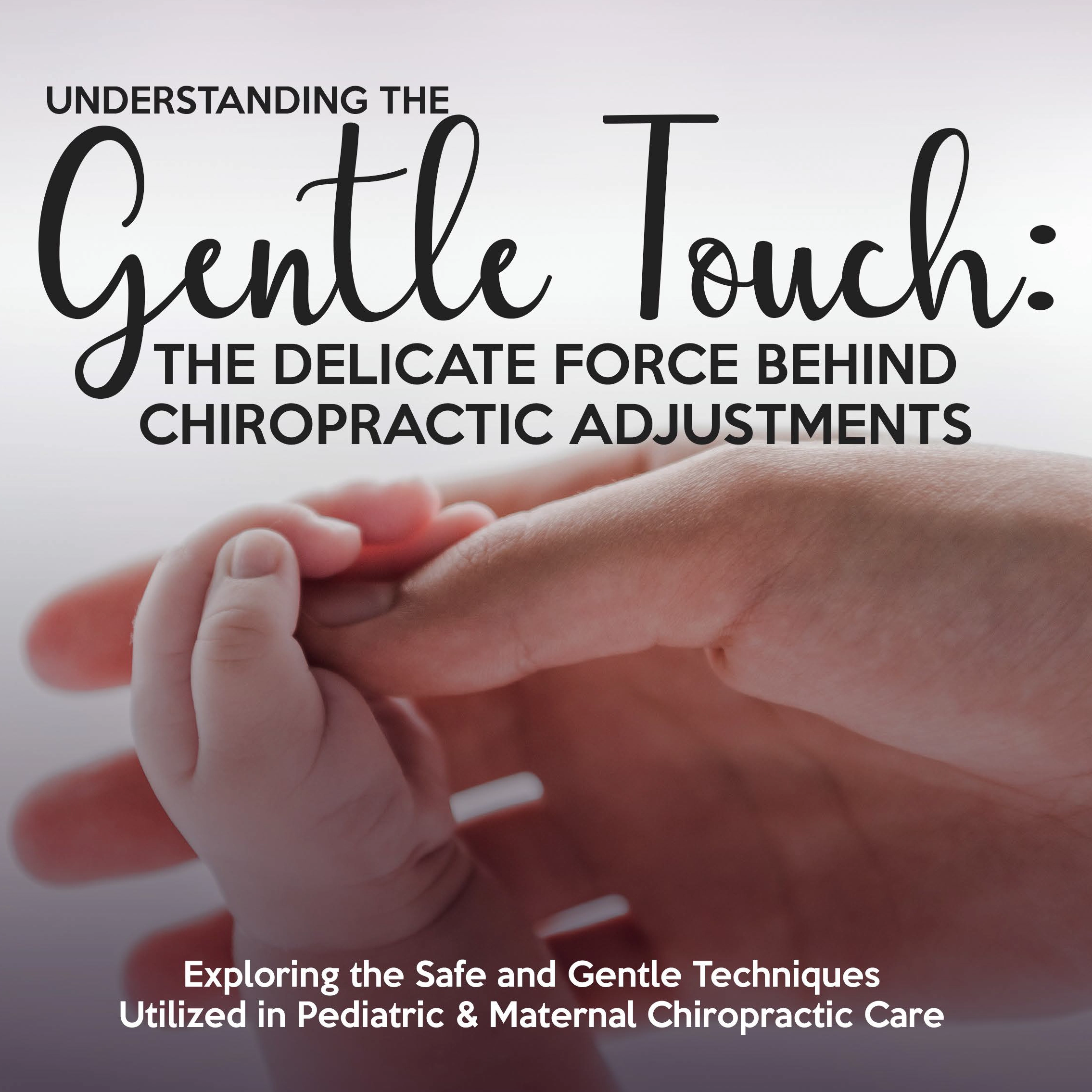Exploring the Safe and Gentle Techniques Utilized in Pediatric and Maternal Chiropractic Care
*This information provided by ChiroFutures Malpractice Insurance Program
 As a leading malpractice insurance program, ChiroFutures prioritizes the safety and well-being of patients, including children and pregnant women. It is our duty to address concerns and provide accurate information regarding the forces used by chiropractors in caring for these vulnerable populations. In this review, we aim to dispel myths surrounding the forces used during chiropractic adjustments and the supposed risks associated with joint hypermobility in children and pregnant women. By exploring the gentle touch and specialized techniques employed by chiropractors who specialize in pediatric and maternal care, we will shed light on the safe and effective nature of ensuring the utmost care and precision when administering gentle forces to promote optimal alignment, function, and well-being.
As a leading malpractice insurance program, ChiroFutures prioritizes the safety and well-being of patients, including children and pregnant women. It is our duty to address concerns and provide accurate information regarding the forces used by chiropractors in caring for these vulnerable populations. In this review, we aim to dispel myths surrounding the forces used during chiropractic adjustments and the supposed risks associated with joint hypermobility in children and pregnant women. By exploring the gentle touch and specialized techniques employed by chiropractors who specialize in pediatric and maternal care, we will shed light on the safe and effective nature of ensuring the utmost care and precision when administering gentle forces to promote optimal alignment, function, and well-being.
Myth – Chiropractic May be Dangerous for Babies & Pregnant Women
 ChiroFutures Malpractice Insurance Program is not aware of any actuarial data showing an increase in adverse events from the tens of millions of pediatric and pregnancy-related visits occurring every single year. In fact, malpractice rates for chiropractors in the United States range from a few hundred to just a few thousand dollars per year.
ChiroFutures Malpractice Insurance Program is not aware of any actuarial data showing an increase in adverse events from the tens of millions of pediatric and pregnancy-related visits occurring every single year. In fact, malpractice rates for chiropractors in the United States range from a few hundred to just a few thousand dollars per year.
Contrast this with the tens of thousands of dollars per year that obstetricians, pediatricians, orthopedists, and other medical specialists involved in the care of children and pregnant women pay, and anyone can see for themselves which profession is safer
Chiropractic for Infants & Children
Parents naturally prioritize the safety and well-being of their children. When it comes to seeking healthcare for infants, it is essential to understand the level of care and precision involved, particularly in practices such as pediatric chiropractic adjustments. In the following paragraphs, we will delve into the amount of force used by chiropractors when adjusting an infant’s spine, shedding light on the gentle touch and specialized techniques employed to ensure the safety and comfort of the youngest patients.
Exploring the Gentle Touch
 Contrary to popular misconceptions, chiropractic adjustments for infants involve minimal force and are performed with utmost care. Pediatric chiropractors are highly trained professionals who understand the unique anatomy and needs of infants. They utilize techniques that are specifically designed for the delicate structure of a baby’s spine.
Contrary to popular misconceptions, chiropractic adjustments for infants involve minimal force and are performed with utmost care. Pediatric chiropractors are highly trained professionals who understand the unique anatomy and needs of infants. They utilize techniques that are specifically designed for the delicate structure of a baby’s spine.
During an adjustment in children, chiropractors apply a gentle, controlled force using their fingertips or the pads of their hands. The amount of force used is comparable to the pressure you might apply while testing the ripeness of a tomato or checking the pulse on your wrist. The intention is to restore proper alignment and mobility to the spinal joints, promoting optimal nervous system function.
Specialized Techniques for Infant Adjustments
Chiropractors are well-versed in a variety of specialized techniques that ensure safe and effective adjustments for infants. These techniques prioritize the comfort and well-being of the child throughout the process.
One such technique is known as the “finger-tip adjustment.” Using only the gentle pressure of their fingertips, chiropractors apply precise movements to guide the vertebrae into proper alignment. This technique is particularly suitable for infants due to its minimal force and delicate touch.
Another commonly employed technique is the “toggle recoil.” Here, the chiropractor uses their fingertips to apply a quick, gentle impulse to the affected joint, promoting a subtle release of tension and misalignment. This technique is carefully performed with the utmost consideration for the infant’s comfort and safety.
Hypermobility – Dispelling the Myth:
Children’s Spines and Chiropractic Adjustments
There is a common misconception that children’s spines are already “hypermobile,” meaning the spinal joints have too much movement in them already, leading some to believe that chiropractic adjustments are unnecessary or even risky for young patients. However, it is important to separate fact from fiction when it comes to pediatric chiropractic care.
Contrary to the myth, children’s spines are not inherently hypermobile. While infants do possess a degree of flexibility due to their developing musculoskeletal system, it is a natural and necessary part of their growth process. As children grow, their spines gradually stabilize and become more resilient.
Chiropractors are highly trained professionals who understand the unique needs and characteristics of children’s spines. They utilize gentle, age-appropriate techniques that are specifically designed to address the specific neuro-musculoskeletal issues that children may encounter, such as misalignments or restrictions.
Chiropractic adjustments for children are safe and effective when performed by chiropractors. These adjustments involve minimal force and are carefully tailored to the child’s size, age, and condition. The goal is to restore proper alignment and function to the spine, promoting optimal nervous system health and overall well-being.
The false notion that children’s spines are already too hypermobile and therefore should not be adjusted by chiropractors is a myth. Pediatric chiropractic care, when performed by trained professionals, is safe and beneficial.
Research Shows Chiropractors Use Low Forces When Adjusting Children
Research aimed to demonstrate the feasibility of quantifying the forces exerted by a chiropractor on children and adults during adjustments has been performed. One such study involved measuring the force-time profiles of adjustments in children ranging from 14 weeks to 17 years old and adults in a clinical setting. The outcome variables, such as peak forces, thrust forces, and rates of force application, were analyzed and compared across age groups.
The results showed that most outcome variables increased with the age of the patient. Specifically, peak forces, thrust forces, and the rate of force application were positively correlated with age, while thrust durations remained constant across all ages. For cervical spine adjustments, preload forces slightly decreased with patient age.
The study concluded that the forces used by the chiropractor increased with the age of the patient, with lower forces being applied to children compared to adults. It emphasized that measuring these forces in clinical practice on patients of different ages was feasible.
The research highlighted the importance of force magnitude and direction in spinal adjustments for successful outcomes. While there have been previous studies on adjustive forces in adults, this research was the first to provide baseline data on the forces used in pediatric patients. The findings contribute to understanding the modification of forces based on patient age and body mass.
The study’s results indicate that chiropractic adjustments are performed with greater force and higher rates of force application as the patient’s age increases. However, the duration of the thrust remains consistent across different age groups.
Overall, this research suggests that quantifying the forces used during chiropractic adjustments in children is possible and provides valuable insights for parents considering chiropractic care for their infants.
Safety First: Collaboration and Communication
Pediatric chiropractors prioritize open communication, collaboration, and autonomy with parents. Before any adjustment, thorough discussions take place to gather essential information about the child’s health history and any specific concerns. This ensures that the chiropractor can tailor their approach to address the unique needs of each child.
Chiropractors undergo extensive education in pediatric care, including learning about the specific techniques and force required for infants. By choosing a reputable chiropractor, parents can rest assured that their child’s safety is a top priority throughout the care process.
Chiropractic adjustments for infants involve minimal force and are performed with great precision and care. Pediatric chiropractors employ specialized techniques that prioritize the comfort and safety of the child. By understanding the gentle touch behind these adjustments, parents can make informed decisions about their child’s healthcare and overall well-being.
Debunking Myths: Chiropractic Adjustments for Pregnant Women Are Too Forceful
Addressing Concerns About Forcefulness and Joint Hypermobility in Pregnancy
Pregnancy is a transformative time in a woman’s life, and it’s common for various discomforts and musculoskeletal issues to arise. Amidst the quest for relief, some misconceptions have arisen regarding the suitability of chiropractic adjustments for pregnant women. Let’s take a moment and dispel the myths surrounding the forcefulness of chiropractic adjustments and concerns about joint hypermobility during pregnancy.
Myth 1: Chiropractic Adjustments are Too Forceful for Pregnant Women:
One of the most prevalent myths surrounding chiropractic care during pregnancy is the assumption that adjustments are excessively forceful. In reality, chiropractors who are knowledgeable about prenatal care are well-versed in adapting their techniques to accommodate the unique needs of pregnant women. They employ gentle, low-force adjustments that prioritize the safety and comfort of both mother and baby.
Pregnancy-specific chiropractic adjustments utilize techniques like the Webster technique, which focuses on aligning the pelvis to promote optimal balance and function. These adjustments involve minimal force and are carefully tailored to the pregnant woman’s changing body, ensuring a safe and effective adjustment.
Myth 2: Joint Hypermobility Makes Chiropractic Adjustments Unsafe:
Another concern often raised is that pregnancy hormones, such as relaxin, cause excessive joint laxity and hypermobility, making chiropractic adjustments unsafe. While it’s true that relaxin can increase joint flexibility, skilled chiropractors are trained to work within these physiological changes. Chiropractors who are knowledgeable about prenatal care possess the knowledge and experience to adjust for the increased joint mobility. They understand the specific needs and considerations of pregnant women, adapting their techniques accordingly. By applying gentle and precise adjustments, chiropractors can address discomfort and misalignments without compromising joint stability.
Benefits of Chiropractic Care During Pregnancy
Many women find relief from various pregnancy-related conditions, including back pain, pelvic pain, sciatica, and round ligament pain, through chiropractic adjustments.
Chiropractic care aims to restore proper alignment to the spine and pelvis, reducing tension on the supporting ligaments and muscles. By optimizing the musculoskeletal system, chiropractic adjustments can alleviate discomfort and enhance overall well-being during pregnancy.
Additionally, chiropractic care can have a positive impact on the nervous system. As the spine is aligned, nerve function improves, promoting better communication between the brain and the body.
This can enhance the body’s ability to adapt to the physiological changes of pregnancy and support the overall health of both mother and baby.
To ensure the highest standard of care, pregnant women should seek out chiropractors who are knowledgeable about prenatal care. These professionals possess the knowledge and expertise to provide safe and effective chiropractic care for expectant mothers.
Furthermore, communication between the pregnant woman and her healthcare providers is vital. By keeping the entire care team informed, including obstetricians and midwives, a collaborative approach can be adopted to ensure the best outcomes for both mother and baby.
Chiropractic care during pregnancy can be a valuable resource for women. By dispelling the myths surrounding forcefulness and joint hypermobility, we encourage pregnant women to explore the benefits of chiropractic adjustments. With the expertise of qualified chiropractors, adjustments can be tailored to the unique needs of pregnant women, promoting optimal comfort, alignment, and overall well-being throughout this transformative journey.
Chiropractic Adjustments are SAFE and EFFECTIVE in Children and Pregnant Women
Through collaboration, communication, and a deep understanding of the unique needs of children and pregnant women, chiropractors ensure the utmost care and precision when administering gentle forces to promote optimal alignment, function, and well-being.
Conclusion
As a malpractice insurance company, we understand the concerns and misconceptions surrounding the forces used in chiropractic adjustments for children and pregnant women. However, it is important to dispel these myths and shed light on the gentle touch and specialized techniques employed by chiropractors who specialize in pediatric and maternal care. Research has shown that chiropractic adjustments for children involve minimal force, carefully tailored to their size, age, and condition.
The techniques used prioritize the safety and comfort of the child, ensuring effective adjustments while promoting optimal nervous system function.
Similarly, chiropractic care during pregnancy utilizes gentle, low-force adjustments, specifically designed for the changing body of the expectant mother.
Skilled chiropractors work within the physiological changes caused by pregnancy hormones, adapting their techniques to address discomfort and misalignments. By restoring proper alignment to the spine and pelvis, chiropractic adjustments offer relief from common pregnancy-related conditions.
Safety precautions, such as collaborating with other healthcare providers, further enhance the well-being of both mother and baby. By dispelling these myths and providing accurate information, we hope to encourage parents and expectant mothers to consider the safe and beneficial nature of chiropractic care for their children and themselves.

